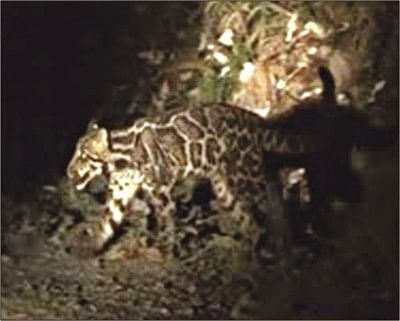Research on Borneo's elusive cat now possible

The Sunderland Clouded Leopard stalking through the Dermakot forest reserve in Borneo
Recently, something phenomenal took place in the Malaysian Borneo's Sabah state's Dermakot Forest Reserve. On 15th February, a Sundaland Clouded Leopard, the latest and the least understood of all cat species, has been filmed for the very first time ever! This 3-foot long and about 90-pound big cat, caught on video at night, seemed remarkably calm as it coolly walked right past the researchers, gently braving the powerful spot-lights and the alien roar of the vehicle's engine. According to Azlan Mohamed, a field scientist at the University of Sabah, "What surprised us was that while clouded leopards are very elusive cats, this one was not scared at all". Azlan along with the team-leader Andreas Wilting, who filmed the wild cat and released the footage for public viewing, are members of the Berlin-based research group Leibniz Institute for Zoo and Wildlife Research studying the carnivores in Sabah region.
Previously it was thought that all clouded leopards living across the South-East Asian mainland were of the same species (Neofelis nebulosa). But in 2006, through genetic studies, this particular Bornean Clouded Leopard was identified as a distinct species and was renamed in its own right. The two separate species are thought to have diverged over 1.5 million years ago. Even though the Sundaland Clouded Leopard or Neofelis diardi is the biggest predator in Borneo, an island between Malaysia and Indonesia, its habitat is under constant threat from poaching, rapid deforestation and widespread plantation of exotic rubber and oil-palm trees. And this gradual deterioration of its habitat has compelled the International Union for the Conservation of Nature (IUCN) to categorize it as a vulnerable species in 2008. Despite its name, the Bornean Clouded Leopard is not closely related to the leopard family; rather it is a medium-sized wild cat mostly confined to Borneo, Sumatra and the Batu Islands in the Malay Archipelago. The exact size this cat's population is yet to be ascertained. However, according to recent studies, the wild cat population is between 5,000 and 11,000 in Borneo and between 3,000 and 7,000 in Sumatra.
The research team from Berlin, as part of their survey, scouted the forest reserve every night in a vehicle and after 11 months of such intense effort encountered a member of the solitary species walking along a road this month. The Dermakot Forest Reserve, which is a 500 sq km area, is also the home to Asia's four other threatened wild cats. And amazingly, this dedicated team of scientists managed to capture images of all these creatures! Armed with 60 cameras placed in the Forest Reserve, the team captured the pictures of the Marbled cat, Flat-headed cat, Leopard cat and Borneo Bay cat. But it is the Sundaland Clouded Leopard, the most obscure of all cats that truly stands out.
Very little is known about the creature in the scientific community, mostly because of its nocturnal habits and secretive behaviour aside from the fact that its numbers are gradually declining. In the words of Andreas Wilting, "Almost no detailed study about their ecology has been conducted". Naturally, the scientists are very enthusiastic about this recent footage of the wild cat, which many believe have provided fresh impetus to the study of this unique species.

 For all latest news, follow The Daily Star's Google News channel.
For all latest news, follow The Daily Star's Google News channel. 



Comments